NFT overflow
Mycle2313
10 years ago
So last week I changed out my nutrient and everything looks great however I looked out my window and saw the water just pouring out the top pipe. The dill plants had huge roots and so blocked the way. So I put in a faucet Y off the pump and turned down the flow up to the top run and the other out back into the nutrient. So lesson learned when the roots are soooo sooooo big better to keep the nutrient flow down.
Question should roots be cut if ever out of control?

PupillaCharites
PupillaCharites
Related Professionals
Tempe Landscape Architects & Landscape Designers · Arnold Landscape Architects & Landscape Designers · Signal Hill Landscape Architects & Landscape Designers · Wixom Landscape Architects & Landscape Designers · Boca Raton Landscape Contractors · Essex Landscape Contractors · Fort Atkinson Landscape Contractors · Fort Payne Landscape Contractors · Gresham Landscape Contractors · Kahului Landscape Contractors · Milford Mill Landscape Contractors · Northbridge Landscape Contractors · Seven Hills Landscape Contractors · Lauderdale Lakes Landscape Contractors · Hawaiian Gardens Landscape Contractorsrobert_1943
PupillaCharites